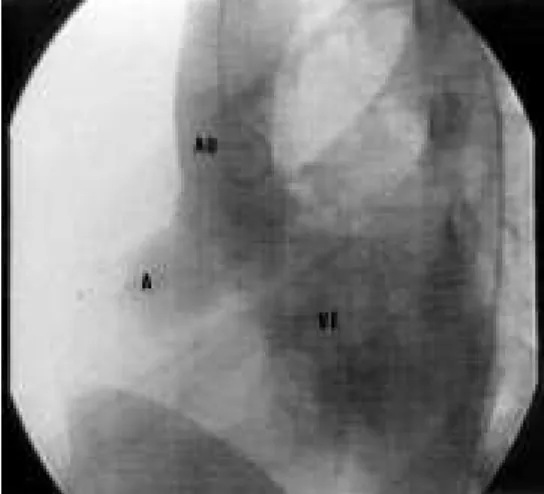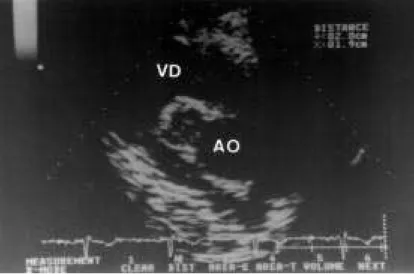CASE REPORT
Non-coronary sinus of Valsalva aneurysm
diagnosed after a road tra
Y
c accident
 Ribeiro, F Fernandes, A Costeira, A Simo˜es, P Rodrigues
Abstract
A 38 year old man with a huge unruptured sinus of Valsalva aneurysm, complicated with severe valvar aortic regurgitation, is described. The aneurysm was detected by echocardiography in the asymptomatic patient who presented with an intense precordial diastolic rumble after a road traYc accident. The patient had success-ful surgery for the aneurysm and aortic valve replacement. Possible aetiologies for the aneurysm and a brief revision of clini-cal aspects and treatment are discussed.
(Heart1999;82:e5)
Keywords: sinus of Valsalva aneurysm; valvar disorders; trauma
A 38 year old man was admitted to hospital after a road traYc accident. He had multiple lesions including thoracic trauma with rib frac-ture and deceleration injuries—that is, plexus brachial stretching. Although he had no previ-ous cardiac complications, a heart murmur was detected, and he was therefore referred to the cardiology department. Examination revealed divergent arterial pressure, hyperkinetic arte-rial pulse, and a long diastolic heart murmur. Transthoracic echocardiography with Doppler colour flow mapping showed normal cardiac chambers, dilatation of the aortic root (the
sac-cular image suggested a sinus of Valsalva aneu-rysm), morphologically normal valves, good left ventricular systolic function, and a moder-ate to severe aortic regurgitation with no other abnormal flows. A transoesophageal echocar-diogram was taken for a better image and showed a huge unruptured aneurysm (fig 1), which appeared to involve two Valsalva sinuses (non-coronary and right), and severe aortic regurgitation. Cardiac catheterisation indi-cated a similar pathology to that seen in the echocardiogram; other coronary vessels were normal (fig 2). Surgery revealed the aneurysm to be non-coronary and it was therefore corrected by direct sewing; the aortic valve was replaced with a St Jude prosthesis. There were no postoperative complications and the patient was discharged on the seventh day.
An echocardiogram taken after the operation shows the para-aortic image in the right coron-ary cusp, and corresponds to the sinus of Valsalva aneurysm without interior flow (fig 3). The aortic mechanical prosthesis had normal gradients and the cardiac chambers had normal dimensions; systolic left ventricular function was maintained and the patient was free from cardiac symptoms.
Discussion
Sinus of Valsalva aneurysms are rare among cardiac surgery patients and it is extremely unusual to find them unruptured or asympto-matic. They are saccular pathological dilata-Figure 1 Multiplane transoesophageal echocardiogram showing a huge sinus of Valsalva
aneurysm (A) which appears to involve the right coronary and non-coronary sinuses. AE, left atrium; AD, right atrium; AO, aorta.
Figure 2 Aortogram showing the sinus of Valsalva aneurysm (A). AO, aorta; VE, left ventricle.
Heart1999;82:e5 (http://www.heartjnl.com/cgi/content/full/82/4/e5) 1 of 3
Department of Cardiology, Hospital de S. Marcos, 4700 Braga, Portugal
 Ribeiro F Fernandes A Costeira A Simo˜es P Rodrigues Correspondence to: Dr Ribeiro.
Accepted for publication 27 April 1999
group.bmj.com
on January 10, 2013 - Published by
heart.bmj.com
tions of the aortic sinus outlined by a thin wall, caused by a lack of elastic or muscular tissue in the aortic root which causes the media of the aortic root and the fibrous annulus of the aor-tic valve to separate; they are usually congenital in origin. They are frequently found in the area of the right sinus of Valsalva, but are less frequent in the non-coronary sinuses and are rarely found at the left coronary cusp. They are also often associated with the other congenital cardiac malformations—for example, ventricu-lar septal defects are present in 30–60% of cases, and aortic valve anomalies (bicuspid valve or prolapse) are seen in 10%.1–3
Aneurysms can be caused by bacterial endo-carditis, trauma, degeneration of the aortic root, medionecrosis, and atherosclerosis,2–4
and can involve multiple sinuses of Valsalva (10%) and the ascending aorta and more extensive portions of the aortic root.2
In most cases, sinus of Valsalva aneurysms are diagnosed by trans-thoracic echocardiography because it enables the aortic root to be seen clearly. Doppler col-our flow echocardiography is the best tech-nique for the detection of complications— for example, aneurysm rupture, but sometimes transoesophageal echocardiography is more appropriate as it provides a clearer image of a fistulised aneurysm.5 6
The most frequent complication is the rupture in the cardiac chambers (generally the right cavities) which usually occurs in men aged between 30 and 40 and develops into gradual or acute heart failure, with the presence of a harsh continuous murmur in the precordium. Fistulisation is rarely asympto-matic. Other complications of sinus of Valsalva aneurysms are aneurysm infection, obstruction of the right ventricle outflow tract, extension of the interventricular septum leading to malig-nant arrhythmias and conduction distur-bances, an intramural thrombus causing ob-struction of coronary ostia, and myocardial ischaemia.7
Ruptures in non-congenital cases are usually fatal, and occur in the pericardial or pleural cavity and, less frequently, in the right cardiac chambers.
Symptomatic or complicated aneurysms can be treated by surgery with excellent results, and the risk to asymptomatic patients is low, although associated complications (valvar aor-tic regurgitation, left ventricular dysfunction, aortic root and ascending aorta involvement, infection, and associated congenital cardiac malformations) may increase the risk.
Treatment of asymptomatic and uncompli-cated sinus of Valsalva aneurysms is controver-sial. Opinion is divided between those who see surgery as a last resort and those who think it is necessary to prevent the development of potentially fatal complications.7–9
Currently, there are no follow up studies of asymptomatic and uncomplicated sinus of Valsalva aneu-rysms that could set a precedent for treatment of the condition.8
Furthermore, surgical management de-pends on whether the aneurysm has ruptured and whether there is aortic valvar insufficiency or ventricular septal defect. The aim of surgery is to close the aneurysmal sac, thus avoiding the creation of aortic valve dysfunction.10
If the aortic valve is involved and the coronary ostia originate in the aneurysm area, aortic valve
and aortic root replacement may be
necessary.1 2
Sinus of Valsalva aneurysms may be con-genital or acquired through trauma, and although the latter are very rare, some cases have been described in which these aneuryms are seen in survivors of road traYc accidents. The aortic isthmus is often the most aVected part of the body in accidents where injury has been caused as a direct result of deceleration: such lesions are rare in the aortic root, and often fatal.4
Thus, the discovery of this type of aneurysm in a healthy man with no history of heart disease, after an accident, favours a diagnosis of an aneurysm of acquired traumatic origin, and recently developed aortic insuYciency, despite the rare asymptomatic acute aortic regurgita-tion.
Nevertheless, the aneurysm and aortic insuf-ficiency could have been congenital, with mild and asymptomatic regurgitation which had recently worsened and resulted in the heart murmur detected after the accident. The left ventricle was not dilated and, therefore, it is possible that this patient had been asympto-matic for a long time and that the aneurysm and aortic regurgitation were found coinciden-tally at the time of the crash. However, as no echocardiogram was taken before the road traYc accident, the pre-existence of the condi-tion cannot be confirmed and the symptoms support the diagnosis of an aneurysm acquired through trauma.
We gratefully acknowledge the assistance of Mrs Mª Júlia Ribeiro.
1 Simic O, Schneider B, Stein J,et al. Unruptured aneurysms of the non-coronary and left sinuses of Valsalva accompa-nied by severe aortic valve regurgitation. Eur J Cardiotho-racic Surg1996;10:1030–2.
2 Holman WL. Aneurysms of the sinuses of Valsalva. In: Sabiston DC, Spencer FC, eds. Surgery of the chest. Philadelphia: WB Saunders & Co, 1995:1316–26.
Figure 3 Postoperative transthoracic echocardiogram, parasternal short axis: para-aortic image is in the right coronary area; maximum dimensions 2 cm×1.9 cm, corresponding to the obliterated sinus of Valsalva aneurysm. VD, right ventricle; AO, aorta.
2 of 3 Ribeiro, Fernandes, Costeira, et al
group.bmj.com
on January 10, 2013 - Published by
heart.bmj.com
3 Friedman WF. Aortic sinus aneurysm and fistula. In: Braunwald E, ed.Heart disease. A text book of cardiovas-cular medicine. Philadelphia: WB Saunders & Co, 1997: 910–11.
4 Gharzudine WS, Sawaya JI, Kazma HK,et al. Traumatic pseudoaneurysm of the left sinus of Valsalva: a case report.
J Am Soc Echocardiography1997;10:377–80.
5 Feigenbaum H. Sinus of Valsalva aneurysms. In: Feigen-baum H, ed. Echocardiography. Pennsylvania: Lea and Febiger, 1994:646–7.
6 Jain SP, Mahan EF, Nanda NC,et al. Doppler colour flow mapping in the diagnosis of sinus of Valsalva aneurysm.
Echocardiography1989;6:533–4.
7 Hiyamuta K, Ohtsuki T, Shimamatsu M,et al. Aneurysm of the left aortic sinus causing acute myocardial infarction.
Circulation1983;67:1151–4.
8 Jebara VA, Chavaud S, Portoghese M,et al. Isolated extrac-ardiac unruptured sinus of Valsalva aneurysms.Ann Thorac Surg1992;54:323–6.
9 Williams TG, Williams BT. Isolated unruptured aneurysm of the left coronary sinus of Valsalva.Ann Thorac Surg
1983;35:556–9.
10 Warnes CA, Maron B J, Jones M,et al. Asymptomatic sinus of valsalva aneurysm causing right ventricular outflow obstruction before and after rupture. Am J Cardiol
1984;84:1383–4.
Non-coronary sinus of Valsalva aneurysm diagnosed after a road traYc accident 3 of 3
group.bmj.com
on January 10, 2013 - Published by
heart.bmj.com
doi: 10.1136/hrt.82.4.e5
1999 82: e5
Heart
 Ribeiro, F Fernandes, A Costeira, et al.
diagnosed after a road traffic accident
Non-coronary sinus of Valsalva aneurysm
http://heart.bmj.com/content/82/4/e5.full.html
Updated information and services can be found at:
These include:
service
Email alerting
box at the top right corner of the online article.
Receive free email alerts when new articles cite this article. Sign up in the
Notes
http://group.bmj.com/group/rights-licensing/permissions
To request permissions go to:
http://journals.bmj.com/cgi/reprintform
To order reprints go to:
http://group.bmj.com/subscribe/
To subscribe to BMJ go to:
group.bmj.com
on January 10, 2013 - Published by
heart.bmj.com

